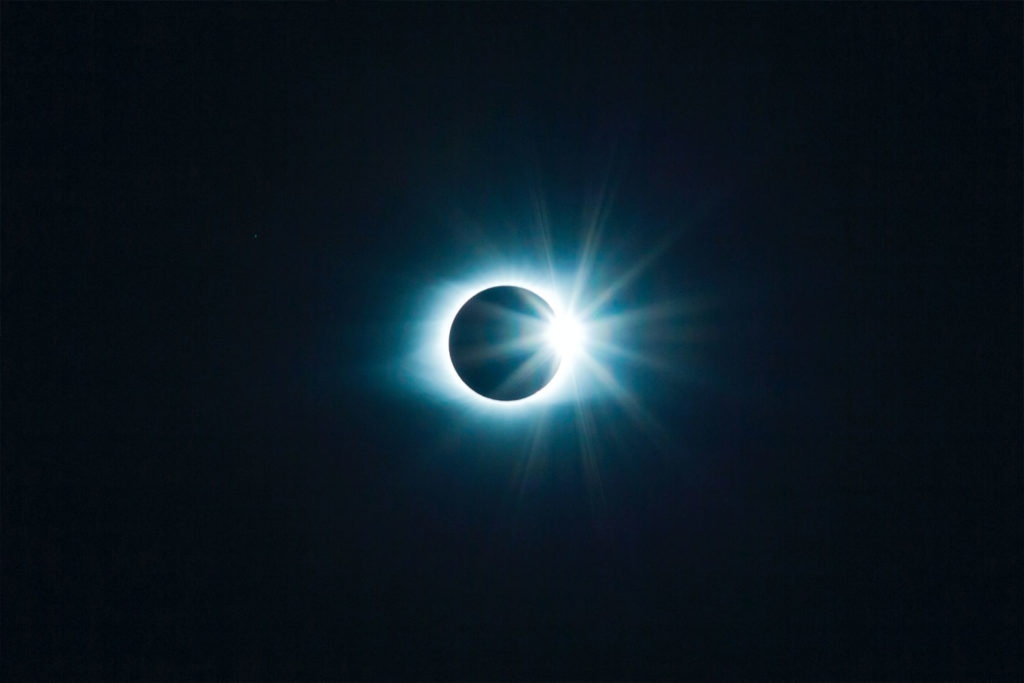by Jay W. Richards and Guillermo Gonzalez
A recurring theme of the 1994 book Pale Blue Dot, by the late astronomer Carl Sagan, is that we are insignificant in the cosmic scheme. In one memorable passage, Sagan pushes this point while reflecting on an image of Earth taken by Voyager 1 in 1990 from some four billion miles away. He writes:
“Because of the reflection of sunlight…Earth seems to be sitting in a beam of light, as if there were some special significance to this small world. But it’s just an accident of geometry and optics…Our posturings, our imagined self-importance, the delusion that we have some privileged position in the Universe, are challenged by this point of pale light. Our planet is a lonely speck in the great enveloping cosmic dark. In our obscurity, in all this vastness, there is no hint that help will come from elsewhere to save us from ourselves.”
You might think that Sagan had an eccentric, melancholy personality. But his sermonette actually expresses an idea popular among modern scientists known as the Copernican Principle. Its proponents trace the history of the principle to its namesake, Nicolaus Copernicus (d. 1543). According to the popular story, Copernicus demoted us by showing that ours was a sun-centered universe, with Earth both rotating around its axis and revolving around the sun like the other planets. He dislodged us from our place of centrality and, therefore, importance. Scientists since Copernicus have only reinforced this initial dethroning. Or so the story goes.
Open virtually any introductory astronomy textbook and you will read some version of this story. It has a single, decisive, problem: it’s false. Historians of science have protested this description of the development of science for decades; but so far, their protests have not trickled down to the masses or the textbook writers.
The real story is much more subtle. We can only sketch it outlines here. The pre-Copernican cosmology was a combination of the physical and metaphysical vision of the Greek philosopher Aristotle (384-322 BC), and the observations and mathematical models of Ptolemy (circa 100-175 AD) and other astronomers. The universe they envisioned was a set of nested, concentric spheres that encircled our spherical, terrestrial globe, a model that nicely explained a whole range of astronomical phenomena in the pre-telescope era. The crystalline spheres were thought to connect so that the movement of the outer, stellar sphere of the stars moved the inner spheres that housed the planets, Sun, and Moon. This model gave order to the east to west movement of the Sun and the Moon, the celestial sphere encircling the celestial poles, and the perplexing and somewhat irregular paths of the known planets.
Although it appears naïve to modern minds, this pre-Copernican cosmology stood out among other cosmologies because it took account of observations of the heavens in trying to discern the structure of the cosmos. In this sense, it reflected a scientific virtue, namely, openness to observation from the natural world.
The view had in its favor the collaboration of common sense observation of the apparent movement of the skies, the apparent stability of the Earth itself, and a number of plausible arguments. For example, if the Earth moved, one would expect a stiff east wind, and that an arrow shot straight in the air would come down west of the archer.
Contrary to popular impression, neither Aristotle nor Ptolemy thought that the Earth was a large part of the universe. Aristotle considered it of “no great size” compared to the heavenly spheres, and in Ptolemy’s masterwork, the Almagest, he says, “The Earth has a ratio of a point to the heavens.” Both of them reached this conclusion because of observations of Earth’s relation to the stars, from which they surmised that the stellar sphere was an enormous distance from the Earth. Copernicus, in his De Revolutionibus, based one of his arguments for the rotation of the Earth on this shared assumption, observing: “How astonishing, if within the space of twenty-four hours the vast universe should rotate rather than its least point!”
More importantly, the “center” of the universe was considered no place of honor, any more than we think of the center of the Earth as being such. And the Earth was certainly not thought to be sitting at the center of Heaven. Quite the opposite. The sublunar domain was the mutable, corruptible, base, and heavy portion of the cosmos. Things were thought to fall to Earth because of their heaviness. The Earth itself was considered the “center” of the cosmos because of its heaviness. The modernist interpretation of geocentrism, then, has it essentially backwards. In our contemporary sense of the words, the Earth in pre-Copernican cosmology was the “bottom” of the universe rather than its “center.”
In contrast, Aristotelians considered the heavens immutable in their regularity and composition. Whereas the sublunary regions were composed of the four mutable elements of earth, water, air, and fire, the heavens were composed of a “fifth element,” called “quintessence” or ether. Heavenly bodies were perfectly spherical, and moved in a circular way befitting their perfection. From this it followed that the laws governing the heavenly realms were quite different and superior to the laws governing the sublunary regions.
When Christian theology was added to the mix in the Middle Ages, the center or bottom of the universe became, quite literally, hell. Dante’s Divine Comedy immortalized this vision, taking the reader from the Earth’s surface through the nine circles of hell, which mirror, and hence reverse, the nine celestial spheres above. Man, composed of both earth and spirit, occupied an intermediate state in which he was a sort of micro-cosmos. He could ascend to the heavenly realm, or descend to the realm of evil, death, and decay. Other purely spiritual beings populated the wider created reality, and God dwelt “above” the outer “empyrean” sphere as the Unmoved Mover of everything else.
Metaphysically speaking, reality in the earlier scheme is God-centered, not man-centered. Thus, Augustine argued that God did not create the world “for man” or out of some necessary compulsion, but simply “because he wanted to.” It’s false, then, to say that the pre-Copernicans gave the Earth and human beings the position of highest esteem, while Copernicus relegated us to an insignificant backwater.
So, far from demoting the status of Earth, Copernicus, Galileo, and Kepler saw the new scheme as exalting it. Galileo in particular defended the notion of “earth shine,” in which Earth reflected the light and glory of the Sun more perfectly than the Moon. He thought that the Earth’s new position removed it from the place of dishonor it occupied in the Aristotelian universe, and placed it in the heavens. In his Sidereus Nuncius, Galileo argues:
“[M]any arguments will be provided to demonstrate a very strong reflection of the sun’s light from the earth-this for the benefit of those who assert, principally on the grounds that it has neither motion nor light, that the earth must be excluded from the dance of the stars. For I will prove that the earth does have motion, that it surpasses the moon in brightness, and that it is not the sump where the universe’s filth and ephemera collect.”
The centrality of Earth in pre-Copernican cosmology meant something entirely different to the pre-Copernicans than it does in the textbook orthodoxy we’ve all learned. There is no simple inference from central location to high status anymore than a modern person would privilege the center of our Earth as the ideal terrestial place to be. Geocentrism did not imply anthropocentrism. Dennis Danielson has written an excellent essay laying to rest the mythology surrounding the Copernican Revolution titled “The Great Copernican Cliché” (American Journal of Physics, October 2001). In it he writes: “The great Copernican cliché is premised upon an uncritical equation of geocentrism with anthropocentrism.” Denying either or both did not automatically disprove the existence of purpose or design in nature.
The official story gives the false impression that Copernicus started a trend, so that removing the Earth from the “center” of the universe led finally, logically, and inevitably to the scientific establishment of our insignificance. By sleight of hand, it transformed a series of metaphysically ambiguous discoveries into the Grand Narrative of Materialism. None of these historical points answers the wider question of our significance in the scheme of things. But it does us good to remember that materialism does not enjoy the historical and scientific pedigree claimed by its adherents.
Published March 30, 2016




